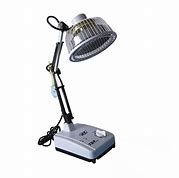Last Updated on 4 months by Francis
If you’re in the process of buying or selling a home, you may have come across the term “infrared home inspections.” But what exactly are they and are they worth it? Infrared home inspections are a valuable tool for uncovering hidden issues that may not be visible to the naked eye. By using advanced thermal imaging technology, these inspections can identify problems such as moisture, heat and energy issues, pest infestations, foundation cracks, ventilation problems, missing insulation, and structural concerns. Let’s take a closer look at the benefits of infrared home inspections.
Contents
Key Takeaways:
- Infrared home inspections can uncover hidden issues in a home that may lead to major problems in the future.
- They use advanced thermal imaging technology to detect moisture, heat and energy problems, pest infestations, foundation cracks, ventilation issues, missing insulation, and structural concerns.
- Infrared inspections provide advantages over traditional visual inspections by identifying hidden problems that may not be visible to the naked eye.
- Choosing infrared inspections can provide peace of mind for both home buyers and sellers.
- While the cost of infrared inspections may vary, they can be cost-effective in the long run by identifying issues before they become costly repairs.
The Advantages of Infrared Inspections

Infrared inspections offer numerous advantages over traditional visual inspections, thanks to the advanced technology they utilize. These inspections can detect hidden problems that may not be visible to the naked eye, providing valuable insights for home buyers and sellers.
“Infrared inspections enable us to identify issues that would otherwise go unnoticed during a visual inspection. The technology allows us to see beyond the surface and uncover underlying problems.” – John Smith, Certified Home Inspector
One of the key advantages of infrared inspections is their ability to identify water leaks and moisture problems. By capturing heat signatures, infrared cameras can detect temperature variations that indicate the presence of water or moisture. This enables early detection and prevention of damage caused by hidden leaks.
Furthermore, infrared inspections are highly effective in detecting electrical faults. By detecting abnormal heat patterns, these inspections can pinpoint areas at risk of electrical damage. This helps prevent potential hazards and ensures the safety of the property’s electrical system.
Structural defects can also be identified through infrared inspections. The technology can reveal hidden issues such as missing insulation, damaged framing, and other structural concerns. Sellers can address these problems before listing the property, enhancing its value and attracting more potential buyers.
One of the primary reasons to choose infrared inspections is the peace of mind they offer. By utilizing advanced technology, these inspections provide a comprehensive assessment of the property, uncovering hidden issues that could lead to costly repairs in the future. This knowledge enables informed decision-making for both buyers and sellers.
Summary of Advantages:
- Detects hidden water leaks and moisture problems
- Identifies potential electrical faults
- Reveals structural defects and insulation issues
- Enhances property value and marketability
- Provides peace of mind for buyers and sellers
How Do Infrared Home Inspections Work?
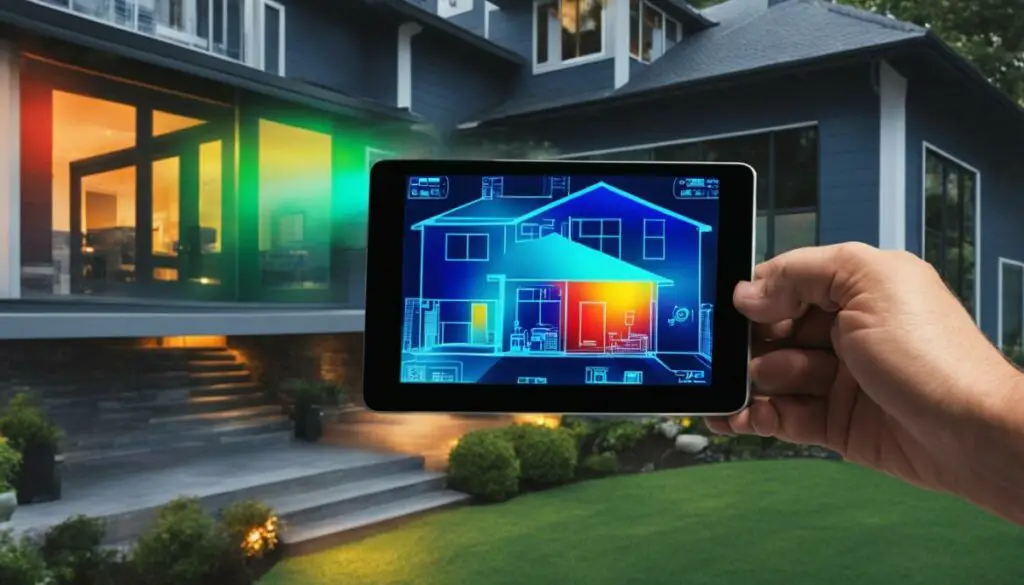
Infrared home inspections utilize the power of thermal imaging technology to uncover hidden issues in a property. By detecting infrared radiation, these inspections provide valuable insights that may not be visible to the naked eye. So, how exactly do infrared home inspections work?
During an infrared inspection, a certified inspector uses a specialized thermal imaging camera. This camera captures the heat signatures emitted by objects and converts them into color-coded images known as thermograms. Different colors on the thermogram represent varying temperatures, enabling inspectors to identify areas of concern within the property.
Capturing Heat Signatures
Using the thermal imaging camera, the inspector scans the property, focusing on various elements such as walls, ceilings, floors, and electrical systems. The camera detects and captures the heat signatures emitted by these objects and surfaces.
Imagine a scenario where water is leaking behind a wall. Although the water might not be visible, it creates a temperature difference compared to the surrounding dry areas. The thermal imaging camera can detect this difference and display it as a color variation on the thermogram.
Interpreting the Thermograms
Once the inspection is complete, the inspector analyzes the captured thermograms. By interpreting the color-coded images, they can identify potential issues and areas that require further investigation.
“Infrared home inspections allow us to uncover hidden problems in a home without destructive testing. The thermograms give us valuable insights, guiding us towards areas that might need repair or attention. It’s like seeing through walls!” – John Smith, Certified Infrared Inspector
Identifying Areas of Concern
With the help of the thermograms, inspectors can identify a wide range of issues during an infrared home inspection. These include:
- Water damage and leaks
- Insulation gaps
- Electrical hot spots
- Heat loss and energy inefficiency
- Mold and moisture intrusion
- Structural defects
Benefits of Infrared Inspections
Infrared home inspections offer numerous benefits to homeowners, buyers, and sellers. By identifying hidden issues early on, infrared inspections can help prevent costly repairs, enhance energy efficiency, and provide peace of mind during real estate transactions.
Now that we understand how infrared home inspections work, let’s explore the cost-effectiveness of these inspections in the next section.
The Cost Effectiveness of Infrared Inspections

While the cost of infrared inspections can vary, they can be highly cost-effective in the long run. By identifying issues that may lead to costly repairs if left unnoticed, infrared inspections empower homeowners to take immediate action and potentially save a significant amount of money on future repairs.
Infrared inspections have the remarkable ability to uncover hidden problems that may not be visible to the naked eye. Whether it’s detecting water leaks, identifying insulation gaps, or pinpointing electrical faults, these inspections provide invaluable insights that can prevent further damage and avoid expensive repairs down the line.
By investing in an infrared home inspection, homeowners are proactively addressing potential issues before they escalate, ultimately saving themselves from the financial burden that major repairs can bring. Catching problems early on allows for timely repairs or maintenance, which tend to be more affordable and less disruptive compared to extensive renovations or replacements.
Furthermore, infrared inspections provide a comprehensive assessment of a property’s condition, allowing homeowners to make informed decisions based on factual information. It enables them to negotiate pricing, obtain accurate estimates for necessary repairs, or even opt-out of purchasing a property with substantial hidden issues.
Ultimately, the cost effectiveness of infrared inspections lies in their ability to detect problems early, which leads to timely and efficient solutions. By addressing minor issues promptly, homeowners can prevent them from escalating into major and more expensive problems in the future. This proactive approach not only safeguards their investment but also ensures a safer and more comfortable living environment for themselves and their families.
Is Infrared Home Inspection Necessary?
While not all home inspections require infrared technology, it can be beneficial in certain situations. If there are concerns about hidden problems or if the property has a history of issues such as water damage or electrical faults, an infrared home inspection can provide a more comprehensive assessment.
Traditional visual inspections may miss underlying issues that can go unnoticed and potentially lead to expensive repairs down the line. Infrared inspections, on the other hand, use advanced thermal imaging technology to detect anomalies that are invisible to the naked eye.
The Benefits of Infrared Home Inspection
“Infrared inspection helps to uncover hidden issues that may be invisible during a visual inspection.”
Infrared home inspections can reveal moisture problems, heat & energy issues, pest infestations, foundation cracks, ventilation problems, missing insulation, and structural concerns.
By identifying these issues early on, homeowners can take prompt action to address the problems and prevent further damage. This can potentially save them from costly repairs and ensure the safety and comfort of their homes.
Additionally, if you’re considering selling your property, an infrared home inspection can help you address any significant problems before listing it, potentially increasing its value and attracting more buyers.
When Is Infrared Home Inspection Necessary?
While not every property may require an infrared home inspection, there are certain situations where it can be particularly valuable:
- If the property has a history of water damage or electrical faults
- If there are concerns about hidden issues that may not be visible during a visual inspection
- If the property has older insulation or structural components that may be prone to problems
In these cases, an infrared home inspection can provide a more thorough evaluation of the property, giving homeowners and potential buyers a clearer understanding of its condition.
Overall, while infrared home inspections may not always be necessary, they can offer significant benefits in certain circumstances. By detecting hidden issues and providing a more detailed assessment, they can help homeowners make informed decisions and ensure the long-term integrity of their properties.
Roofing Leaks and Moisture Detection
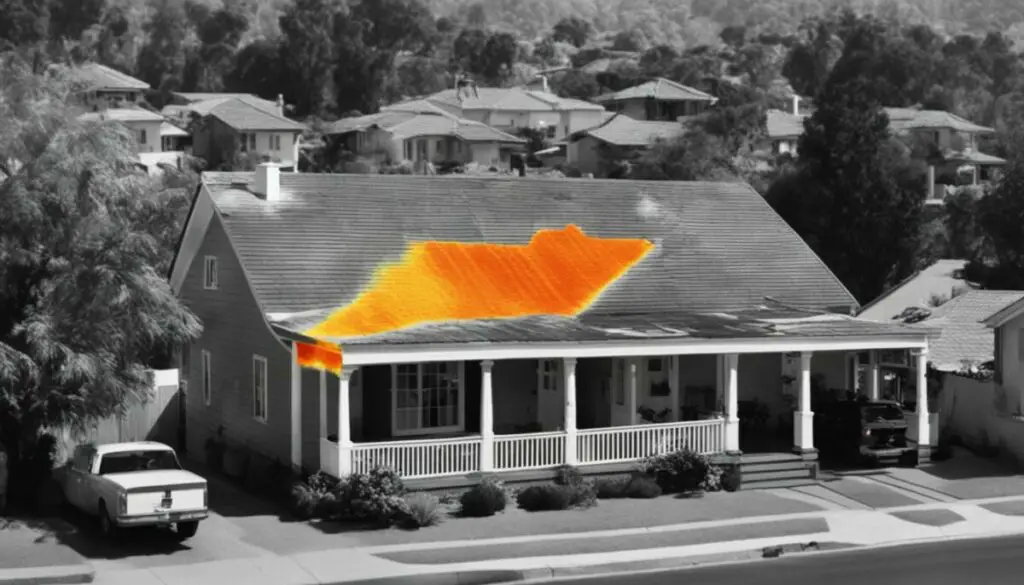
Infrared inspections are a powerful tool for detecting roofing leaks and moisture problems in homes. By utilizing thermal imaging technology, these inspections can identify temperature differences caused by water intrusion. In the summer, water will appear as warmer spots on the thermal image taken at night, while during the winter, it will show as colder spots. This makes it easier for inspectors to pinpoint potential issues and take necessary steps to address them.
The ability of infrared inspections to detect roofing leaks and moisture problems is invaluable in preventing further damage. By identifying these issues early on, homeowners can effectively mitigate potential risks and avoid costly repairs in the long run.
| Roofing Leaks and Moisture Detection | Advantages for Homeowners |
|---|---|
| Easily detects moisture and roofing leaks using thermal imaging technology | Prevents further damage and costly repairs |
| Pinpoints potential issues by identifying temperature differences caused by water intrusion | Mitigates potential risks and enhances the durability of the roof |
| Helps homeowners make informed decisions regarding necessary repairs or replacements | Ensures the long-term integrity of the roof and the overall structure of the home |
Electrical Fault Detection
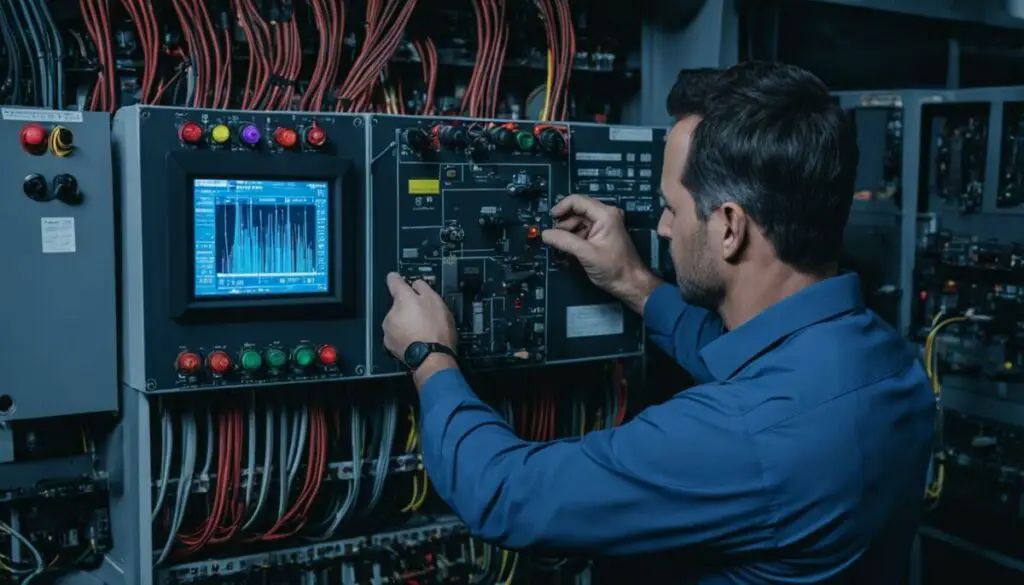
Infrared inspections are an effective method for detecting electrical faults in residential and commercial properties. By utilizing advanced thermal imaging cameras, inspectors can quickly identify abnormal heat patterns that indicate potential electrical issues. These inspections play a crucial role in ensuring the safety of a property and preventing electrical hazards.
During an infrared inspection, the thermal imaging camera captures heat signatures and converts them into color-coded images, known as thermograms. Electrical faults are represented as yellow spots on the thermal image, making it easy for inspectors to pinpoint the exact location of the problem.
Inspection Quote: “Our infrared inspections provide an in-depth analysis of the electrical system, highlighting any abnormalities that may lead to malfunction or pose a risk.”
Identifying electrical faults through infrared inspections can save property owners from potential fires, electrical failures, and costly repairs. By detecting issues early on, necessary repairs can be made to prevent further damage or hazards.
Infrared Inspection Benefits for Electrical Fault Detection:
- Identification of overheating circuits and wiring
- Detection of loose or faulty connections
- Pinpointing overloaded circuits
- Spotting damaged or deteriorating electrical components
An infrared inspection can provide peace of mind by ensuring that electrical systems are functioning safely and efficiently. It is especially crucial for properties with older electrical systems or those that have recently undergone renovations.
| Benefits of Infrared Inspections for Electrical Fault Detection | Traditional Visual Inspections |
|---|---|
| Ability to detect hidden electrical faults | Relies on visible signs of damage or malfunction |
| Quick and accurate identification | Time-consuming and prone to human error |
| Prevention of electrical hazards and fires | May miss underlying issues that could lead to accidents |
| Cost-effective by avoiding major repairs | Expensive repairs may be required after the damage worsens |
Structural Defects and Insulation Problems

Infrared inspections offer a non-invasive approach to detect structural defects and insulation problems in homes. These inspections utilize advanced thermal imaging technology to identify issues that may not be visible to the naked eye. By understanding the presence of missing insulation, damaged framing, and other potential structural concerns, homeowners can address these problems before they worsen and impact the integrity of their property.
With infrared inspections, sellers can benefit from having an infrared scan conducted before placing their home on the market. This proactive measure allows sellers to address any serious structural defects or insulation problems and provide potential buyers with a transparent assessment of the property’s condition. By doing so, sellers can instill confidence in buyers and potentially avoid negotiations, delays, or even abandoned offers due to undisclosed issues.
Benefits of Infrared Inspections for Structural Defects
1. Early Detection: Infrared inspections allow for early detection of structural defects, ensuring prompt repair and preventing further damage.
2. Non-Invasive: Unlike traditional methods that may require invasive testing, infrared inspections are non-invasive, minimizing disruption to the property.
3. Comprehensive Assessment: Infrared inspections provide a comprehensive assessment of structural integrity, identifying hidden defects that may compromise safety and stability.
4. Cost Savings: By identifying structural defects early on, homeowners can address them before they worsen, potentially saving significant repair costs in the long run.
Benefits of Infrared Inspections for Insulation Problems
1. Energy Efficiency: Infrared inspections can identify insulation problems, such as gaps or missing insulation, which can lead to energy loss and increased utility bills.
2. Comfort and Climate Control: Adequate insulation is crucial for maintaining a comfortable indoor environment, and infrared inspections help identify areas where insulation may be lacking.
3. Environmental Impact: Improving insulation can contribute to reduced energy consumption, promoting sustainability and reducing the carbon footprint of a home.
To better understand the significance of infrared inspections for detecting structural defects and insulation problems, take a look at the table below:
| Issue | Infrared Inspection Benefits |
|---|---|
| Missing Insulation | – Identify gaps or areas with insufficient insulation – Enhance energy efficiency and reduce utility costs |
| Structural Defects | – Early detection and prevention of potential safety hazards – Save on costly repairs by addressing issues promptly |
| Damage to Framing | – Uncover hidden damage that may compromise the structural integrity – Ensure a stable and secure living environment |
Real Estate Benefits of Infrared Home Inspections
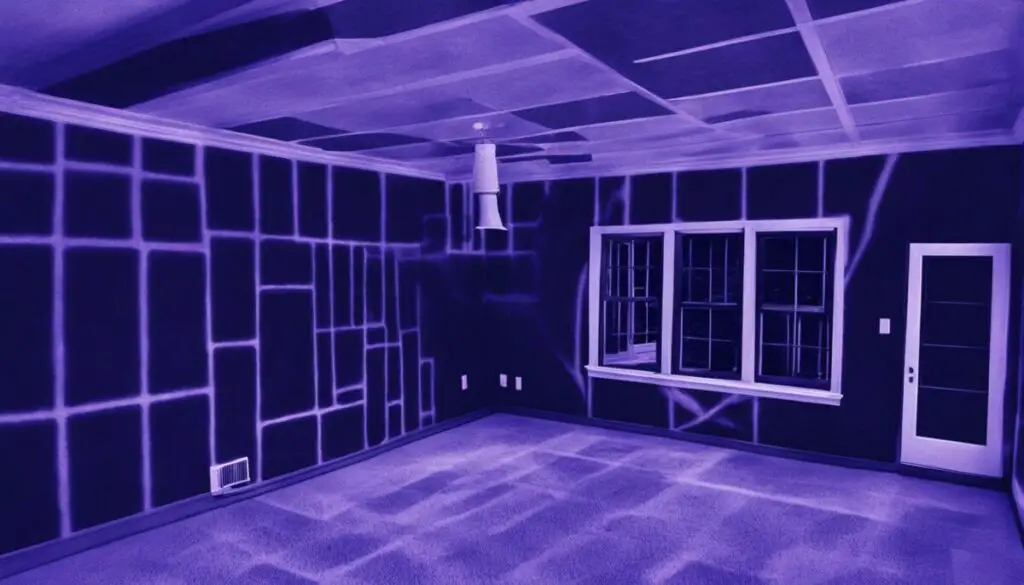
Infrared home inspections provide significant real estate benefits for both buyers and sellers. These inspections offer valuable information that can have a direct impact on the buying and selling process. Here are some key advantages:
- Negotiating Power for Buyers: The findings from an infrared home inspection can give buyers greater negotiating power. By uncovering hidden issues that may not be visible during a standard visual inspection, buyers can use this information to negotiate a lower price or request necessary repairs before finalizing the purchase.
- Identifying Deal Breakers: Infrared home inspections can help buyers identify deal breakers. If significant issues are found during the inspection, buyers have the option to walk away from the property without incurring unnecessary expenses or potential risks.
- Increasing Property Value for Sellers: For sellers, addressing problems discovered during an infrared home inspection can potentially increase the value of the property. By taking proactive steps to resolve any issues, sellers can attract more buyers and potentially sell the property at a higher price.
- Building Trust with Buyers: Sellers can also build trust with potential buyers by providing an infrared home inspection report. This shows transparency and demonstrates that the seller has taken the necessary steps to address any hidden issues, giving buyers peace of mind during the transaction.
- Reducing Liability for Sellers: By conducting an infrared home inspection prior to listing a property, sellers can identify and address any potential liabilities. This proactive approach can help sellers avoid legal complications that may arise if undisclosed issues are discovered after the sale.
In summary, infrared home inspections offer valuable benefits to both buyers and sellers in the real estate market. Buyers gain negotiating power and the ability to make informed decisions, while sellers can increase the value of their property and build trust with potential buyers. Ultimately, these inspections provide peace of mind and facilitate a smoother buying and selling process.
| Real Estate Benefits | Buyers | Sellers |
|---|---|---|
| Negotiating Power | ✓ | |
| Deal Breakers | ✓ | |
| Increasing Property Value | ✓ | |
| Building Trust | ✓ | |
| Reducing Liability | ✓ |
Case Studies: Uncovering Hidden Issues and Reducing Energy Loss
Real-life case studies exemplify the effectiveness of infrared home inspections in uncovering hidden issues and reducing energy loss. These studies demonstrate the practical applications of infrared inspections and their ability to provide valuable insights into the condition of a property.
Case Study 1: Detecting Hidden Water Leak
In one case, an infrared home inspection revealed a hidden water leak within the walls of a home. The thermal imaging camera captured a distinct pattern indicating moisture presence, allowing for prompt identification and subsequent repairs. Detecting and rectifying the water leak prevented further damage to the property, saving the homeowner from potential costly repairs down the line.
Case Study 2: Identifying Insulation Gaps for Energy Savings
Another case study focused on identifying insulation gaps in a residential property. By conducting an infrared inspection, the inspector was able to pinpoint areas where insulation was lacking or improperly installed. Addressing these gaps resulted in improved energy efficiency, lower energy usage, and subsequently reduced utility bills for the homeowner.
These case studies highlight the value of infrared home inspections in identifying hidden issues that may otherwise go unnoticed. By proactively addressing these issues, homeowners can prevent more extensive damage and reduce energy loss, ultimately saving money in the long run.
| Case Study | Issue Detected | Solution |
|---|---|---|
| Case Study 1 | Hidden water leak | Prompt repairs to prevent further damage |
| Case Study 2 | Insulation gaps | Addressing gaps for energy savings |
These examples emphasize the effectiveness of infrared inspections in uncovering hidden issues and the subsequent actions taken to mitigate potential damage and reduce energy loss. Homeowners and buyers can rely on these case studies to gain confidence in the benefits of infrared home inspections and make informed decisions regarding their properties.
Choosing a Reliable Infrared Home Inspection Service
When it comes to choosing an infrared home inspection service, you want to ensure that you’re partnering with a reliable and competent provider. Here are some important factors to consider:
- Certification: Look for inspectors who have received proper certification in infrared thermography. This certification ensures that the inspectors have undergone comprehensive training and have the necessary knowledge and skills to perform accurate inspections.
- Training Standards: Inquire about the training standards followed by the inspection service. It’s essential that their inspectors receive ongoing education and stay up-to-date with the latest industry practices and advancements in infrared technology.
- Experience with Local Building Styles: Choose an inspection service that has experience with the specific building styles prevalent in your area. Different regions may have unique construction techniques, materials, and potential issues. Inspectors familiar with local practices will be better equipped to detect any hidden problems.
- Comprehensiveness of Inspection Reports: Request sample inspection reports from the service providers you are considering. Take a close look at the level of detail and clarity in their reports. A thorough inspection report should provide you with a clear understanding of the identified issues, including supporting evidence such as infrared images, descriptions, and recommendations for further action.
Remember, when it comes to your home, choosing a reliable infrared home inspection service is crucial. Taking the time to ask questions and gain a deeper understanding of the inspection process will ensure that you receive a high-quality, accurate assessment of your property.
Conclusion
Infrared home inspections have revolutionized the way we assess and evaluate properties. By utilizing advanced thermal imaging technology, these inspections have proven to be highly effective in detecting hidden issues that may go unnoticed during traditional visual inspections.
One of the key advantages of infrared inspections is their ability to detect hidden problems such as moisture issues, electrical faults, insulation gaps, and even structural defects. By identifying these issues early on, homeowners can take immediate action to prevent further damage and potentially save significant costs on future repairs.
Furthermore, infrared home inspections play a crucial role in energy conservation. By pinpointing areas of heat loss and energy inefficiencies, homeowners can implement effective solutions to enhance their property’s energy performance, leading to reduced utility bills and a more sustainable home.
In conclusion, infrared home inspections are a valuable investment for both home buyers and sellers. They provide a comprehensive assessment of a property’s condition, uncover hidden issues, prevent future damage, and contribute to energy conservation. Whether you’re looking to purchase a new home or sell your current property, investing in an infrared home inspection will give you peace of mind and long-term well-being for your investment.
FAQ
Are infrared home inspections worth it?
Yes, infrared home inspections are worth it as they uncover hidden issues in a home that may lead to major problems in the future. They can detect moisture problems, heat and energy issues, pest infestations, foundation cracks, ventilation problems, missing insulation, and structural concerns.
What are the benefits of infrared home inspections?
Infrared inspections provide advantages over traditional visual inspections by using advanced technology to detect hidden problems that may not be visible to the naked eye. This includes identifying water leaks, moisture problems, electrical faults, and structural defects. Choosing infrared inspections can provide peace of mind for home buyers and sellers.
How do infrared home inspections work?
Infrared home inspections work by using thermal imaging cameras that detect infrared radiation. These cameras capture heat signatures and convert them into color-coded images called thermograms. Different colors represent different temperatures, allowing inspectors to identify areas of concern such as water damage, insulation gaps, and electrical hot spots.
Are infrared home inspections cost-effective?
While the cost of infrared inspections can vary, they can be cost-effective in the long run by identifying issues that may lead to costly repairs if left unnoticed. By detecting problems early on, homeowners can take immediate action and potentially save money on future repairs.
Is infrared home inspection necessary?
While not all home inspections require infrared technology, it can be beneficial in certain situations. If there are concerns about hidden problems or if the property has a history of issues such as water damage or electrical faults, an infrared home inspection can provide a more comprehensive assessment.
How do infrared inspections detect roofing leaks and moisture problems?
Infrared inspections can easily detect roofing leaks and moisture problems by capturing the temperature differences caused by water. Water will appear as warmer spots in the summer (at night) or colder spots in the winter on the thermal image, making it easier to identify potential issues.
How do infrared inspections detect electrical faults?
Infrared inspections can quickly identify electrical faults by detecting abnormal heat patterns. Electrical damage will show up as yellow spots on the thermal image, allowing inspectors to pinpoint the source of circuit damage and make necessary repairs.
How do infrared inspections detect structural defects and insulation problems?
Infrared inspections are useful for detecting structural defects and insulation problems without invasive testing. They can identify missing insulation, damaged framing, and other structural issues that may impact the integrity of the home. Sellers can benefit from having an infrared scan before selling to address any serious problems.
What are the real estate benefits of infrared home inspections?
Infrared home inspections offer real estate benefits by providing valuable information for both buyers and sellers. Buyers can use the findings to negotiate a lower price or choose not to buy a property with significant issues. Sellers can address problems before listing the property, potentially increasing its value and attracting more buyers.
Are there any case studies on the effectiveness of infrared home inspections?
Yes, real-life case studies showcase the effectiveness of infrared home inspections. In one case, a hidden water leak was detected, allowing for prompt repairs and preventing further damage. In another case, identifying insulation gaps led to lower energy usage and utility bills. These examples demonstrate the value and practical applications of infrared inspections.
How do I choose a reliable infrared home inspection service?
When choosing an infrared home inspection service, it is essential to consider factors such as certification, training standards, experience with local building styles, and the comprehensiveness of inspection reports. Asking questions and understanding the process will help ensure the quality and accuracy of the inspection.






